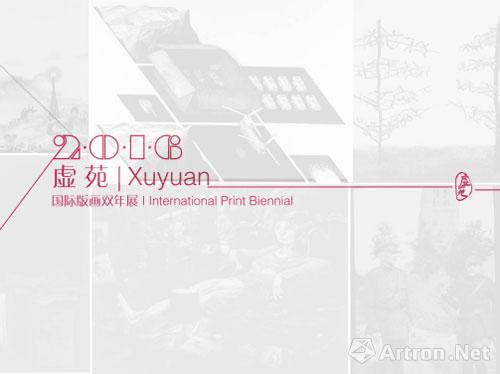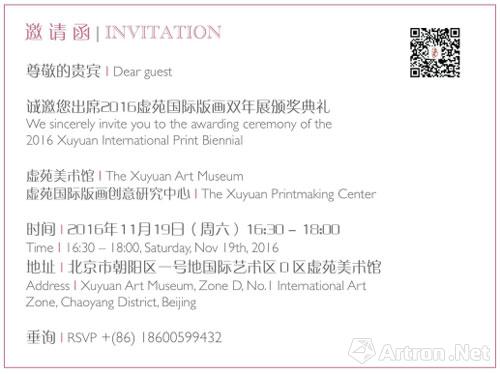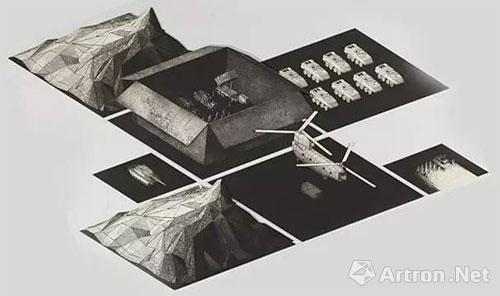摘要:11月19日(周六)下午4:30,首届虚苑国际版画双年展暨颁奖仪式将在虚苑一号地美术馆开幕。多位著名艺术家、多国大使、学者等将到场展开精彩讨论,诚邀您的参与。 北京虚苑美术馆和国际版画创研中心主办的“虚苑国际版画双年展”以促进国际间版画艺术的交流、调动国内外文化艺术资源、展…
11月19日(周六)下午4:30,首届虚苑国际版画双年展暨颁奖仪式将在虚苑一号地美术馆开幕。多位著名艺术家、多国大使、学者等将到场展开精彩讨论,诚邀您的参与。

北京虚苑美术馆和国际版画创研中心主办的“虚苑国际版画双年展”以促进国际间版画艺术的交流、调动国内外文化艺术资源、展示当代版画艺术多元化创作观念及成果为初衷。它以中国历史文脉及现状为依托,联合国内外优秀版画艺术家,共同思考当下版画创作,呈现当代版画在全球语境的生态图谱,以鲜活的视觉艺术方式在全球多元化和本土传统之间建立起一座交往、互动和展示的桥梁。
北京虚苑初创于2011年,是一家以版画、雕塑等复数艺术为核心的文化创意产业投资、推广、开发专业经营机构。经过连续五年的稳步拓展,今天的北京虚苑已经形成了艺术产业链的完整架构,涉及艺术品创作研发与推广、展览展示、教育培训、艺术品投资、艺术金融等多个方面。
北京虚苑是目前国内从事版画艺术原创和经营推广的最大机构,拥有一流的合作艺术家团队和国际水准的学术委员会,以及目前世界上单体面积最大、版种设置最为完备的版画工坊,配备优秀的版画技师和顶级的版画装裱工艺,并接受来自世界各地的优秀艺术家入驻创作。
北京虚苑与中国本土及国际范围内的知名艺术家广泛合作,致力于持续性地推动中国版画艺术产业发展、促进国际交流。北京虚苑拥有文资虚苑美术馆(新华1949园区内)、虚苑美术馆(北京一号地艺术区),共5个主要的展厅空间。“虚苑国际版画双年展”的设立,正是虚苑促进国家版画交流的创举。

二十一世纪是一个信息共享和图像复式的世纪。版画因兼有艺术的实验性和传统的表现功力,理应成为这个时代图像创造的宠儿。
……
为了让当代版画艺术家们的创造收获更广泛的认知,北京虚苑组织了第一届国际当代版画双年展。这是一次探险,一幅完整展示版画这门丰富的艺术形式的“全景图”,一次穿越全球的实践。
它成功地吸引了五十个国家和地区1169名艺术家的积极回应。面对近5000件作品,经过初评选出了245位艺术家入围。截止主办方收稿日期,共收到236位艺术家的作品——中国本土艺术家116位,国外艺术家120位,由国际评委进行最终的评选。评委包括波兰什切青当代美术馆馆长Marlena Chybowska女士;比利时瓦隆法语区当代艺术中心负责人Marie-Hélène Joiret 女士;英国牛津大学艺术学院教授何为民先生;中央美术学院实验艺术学院院长邱志杰先生;美国作家、纽约时报撰稿人Rick Butler 先生;意大利米兰艺术中心负责人Carla Pellegrini女士;意大利记者、社会活动家Jean Toschi Marazzani Visconti女士。
经过两天必要的慎重的评议来选出获奖者,大奖得主为波兰艺术家Kamil Kocurek。
公众将通过展览欣赏到最后选出的88位中外艺术家的精彩作品,我们希望这些作品给大家带来有关今日当代版画艺术的另一种体验。
Daniel Sluse
评委会主席
比利时列日皇家美术学院院长
The twenty-first century is an era of communication and image diversification, in which printmaking, as an experimental art derived from traditional techniques, is the preferred art form of this image age.
……
In order to help these artists make their works of art recognized and understood, Xuyuan made a bold attempt. It holds the First International Contemporary Printmaking Biennial in Beijing to present a comprehensive and diverse picture of contemporary printmaking, just as artists are practicing around the world.
The attempt was successful with 1,169 artists from more than 50 countries registering for the show. Among the 5,000 printmaking works, the works by 245 artists were selected and 236 artists (116 from China and 120 from other countries) were presented to the international jury consisting of Marléna Chybowska, Deputy Director of the Contemporary Art Office of Szczecin Museum in Poland; Marie-Hèlene Joiret, Director of the Wallonia Center for Contemporary Art in Fremare, Liege, Belgium; Prof. He Weimin from Oxford University; Prof. Qiu Zhijie, Director of the Experimental Institute in the Central Academy of Fine Arts; Rick Butler, writer for the New York Times; Carla Pelligrini, Director of the Milan Art Center in Italy; Italian journalist and social activist Jean Toschi Marazzani Visconti.
After a two-day evaluation, the international jury awarded the Grand Prize to the Polish artist Kamil Kocurek.
The works by 88 candidates displayed to the public will show the diversity and high quality of contemporary prints. We also hope to show you a different picture of today's printmaking.
Daniel Sluse
President of the Jury Panel
Director of the Académie Royale des Beaux-Arts, Liege, Belgium
走过二百余幅风格、技法、文化背景跨度极为宽广的作品,观者将会意识到,这是一个丰富而松散的艺术疆域,充满各民族独立的审美意识,却少见地具备共通的技艺与精神内核,将遥远的地域和代际连接起来。
……
在此次双年展中,我们看到,Kamil Kocurek在版画部件之上使用装置手法,以玩具般的方式描绘陆、空武器和地形,充满机智趣味和几何韵律的同时,倾斜构图带有发人深省的不安定感;泰国的Puritip Suriyapatarapun以洁净鲜明的石版套色,在驾驭织物、木纹等材质表达的基础上,于材质表面,用人脸的形象,巧妙地插入对人类个体思想的隐喻;意大利的Toni Pecoraro以铜版蚀刻铺叙古城的细节,且以幻想堆积形体,令人联想到欧洲随想画与都市景观画的传统;中国台湾的李文杰用压克力凹版赋予公共生活情景细腻敏感的质地,记录人与人、人与城市之间的生动关系;加拿大的Guy Langevin用美柔汀技法,将多层次的连贯光影加诸简单的人体动作上,形成接近抽象的视觉效果,引发人对于自我的直觉观感;中国的胡雅静以木版描绘童话意境中的田野和山川,木材肌理和生拙的刀刻韵味为明艳的色彩和富于幻想的构形融入了质朴纯真的气质;顾秀华则在精湛的木口木刻中注入他对自然元素的一贯思考,动物、植物、海浪等通过紧密而深入的构图形成严谨对称,奇异、繁复而恢宏的效果令人震撼。他们与材料交流,令材质在画面上游戏、对话、嬗变。包括大奖得主Kamil Kocurek在内的许多艺术家十分年轻,他们将质感与思想融为一体的能力展现了过人的禀赋与深度。
本次双年展评选得益于专业、多样化的国际评审团,技巧之外,他们提供了各自对当代思想的判断,虽然其中包含着必然的价值和立场冲突。如果说十六世纪以来,世界地图和博物学图鉴记录了探索和贸易扩张;生产效率长足发展之后,独幅版画藉印象派画家回归,因技术本身值得珍视;丝网印刷和波普艺术一起见证了消费主义的兴起;那么我们的时代,信息量骤增,艺术品观赏和筛选的过程加快,制作和获取图像的便捷足以对艺术家构成技术和立意的诱惑,政治题材甚至前所未有地商业化。我们将通过长期的平台支持,对当代潮流作出反馈;从版画领域出发,我们推崇有品质的个人审美,关注思想者的发声。
策展人 周融荣
Walking by the more than two hundred prints that are extensively diverse in styles,techniques and cultural backgrounds, one will realize that such a uniquesubfield of art is rich in content and globally nurtured in different traditions. The independent aesthetic shaped by the history of a nation or acommunity is often easily observed in a print. Yet works from distant origins share the respect for craftsmanship and the core spirit formed in the evolutionof printmaking.
……
In the Biennial, Kamil Kocurek combined prints with installations. He presents fighter planes,tanks and mountains as toys. The tilt in composition brings in a sense ofdanger and instability, which provokes thoughts on the witty, geometric representation of the subjects. Thai artist Puritip Suriyapatarapun applies the neat, saturated colors on lithographs, with mastery in the textile and woodtexture. He inserts the imagery of human faces at details of still life, and composes the metaphor for the contemplative status of individual minds. Toni Pecoraro from Italy describes the ancient city with imaginary elements on copperplates, which reminds of the eighteenth century urban landscapes and the fantasia prints. Li Wenjie from Taiwan prints with acrylic blocks, and portrays the urban daily life with exquisite variations of light and shades. He sensitively records how common individuals interact with each other, and how they are related to the city. Equally refined but with a more abstract approach, Guy Langevin from Canada transforms the simplified human bodies intosmooth flows of tones and curves. Employing mezzotinton copperplate, he evokes intuitive feelings about self-existence. Hu Yajing from China chooses woodblocks to depict the inhabited landscape. The grain of wood and the hard, resistant traces by carving purify her sweet imagination with an understated tone. Another Chinese artist, Gu Xiuhua infuses the philosophical reflections on natural elements with his excellent pear-wooden graving skills. His highly identifiable style is characterized by the symmetry of the dense combinations of animals, plants and waves with a deepperspective. The curious scene heavily filled with sharp linear details is aspectacle.
The selection of the Biennial relies on the professional and diversified international jury panel. Besides the technical standard, they support the process with their comprehension of contemporary thoughts, though there are inevitable conflicts on values and stances. Since the sixteenth century, world maps and illustrations on thenatural history documented the trading expansions and expeditions; after theupgrading of productivity, monotype prints were brought back by the Impressionists for their appreciation of the techniques; serigraphy and pop art witnessed the rise of consumerism. In this era information explodes. The selection and viewing of art works accelerate. Grabbing and producing images were never so convenient, which is alluring to artists both technically and conceptually. Political subjects were never so commercialized in the global market. We respond to the trends by constructing and sustaining a platform to support the value of art. From the field of printmaking, we would passionately promote the quality expressions of individual aesthetics, and the voices from independent thinkers.
Curator Zhou Rongrong

Kamil Kocurek 波兰 Topography od War 2015年 铜版装置 194cmx340cm
版画,顾名思义,经由“版”印制之图像。版可谓木、石、铜、丝等各类材料刻制绘制处理过之材料。未经艺术家处理的材料的原始形态之曰“板”。
古代承载图像之印刷即版画。版画自隋至今可追溯历史近千五百年。其传播功能不亚于今日互联网之功用,版画对世界文明进程的推进,其功或大于任何其他艺术形式。版画经唐至宋元发展,至明代刻印技巧已臻精湛绝伦之境,遂由黑白而套色,由独版而餖版,由平面而立体拱花;但中国古版画多以复制为目的,盖受“道成而上,技成而下”观念影响,上世纪三十年代前中国艺术家亲自刻板之创作鲜见。
欧洲版画起步迟于中国约八百年,后来居上,自文艺复兴以降,丢勒、荷尔拜因、伦勃朗、哥雅、米勒、梵高、毕加索直至当今霍克尼诸家,虽亦借助助手,然莫不亲躬雕镌,木版、凹雕、蚀刻、美柔汀、飞尘、石版、网版乃至电脑版画诸技法层出不穷,五百年来创作版画蔚为大观,凡艺术大师必做版画,概莫能外。
……
国际版画展一个共识是鼓励版画观念与创作技术材料之创新,现代艺术与科技结合已硕果累累,尤其数码技术在版画上的运用极大拓展了版画空间。数码技术使得版成为虚拟的存在,也使得“人人都是版画家”的理论成为可能。然而单纯操作键盘运用打印机输出出来的作品与传统手工制版刻印的版画同台竞技有失公允,如同自行车与方程式赛车不应同场竞技一样,故此次展事,旨在澄清版画本来面目,让版画回到版画本身,强调实体“版”的特性,亦即版画原创性。版依托可触可视之材料,版是图形载体,也是情感的载体。
何为民
组委会秘书长
牛津大学Ruskin艺术学院教授
伦敦木版教育基金会理事
The so-called printmaking, like its name, is a technique to "make" print. The key to "make print" is the medium which endows its essential character and makes it different from other art forms. The medium can be a block or a plate of wood, stone, bronze or silk, which is then inked and used to print the image.
In ancient times, almost all prints were "original" since there were exclusively produced by hand. Since its origin during the Sui Dynasty, print making has celebrated its almost 1500 years of history, and the importance of its invention is comparable to that of Internet today. Printing technology accelerated civilizations and in that respect no other art form compares withit. Woodblock printmaking in China developed through the Tang, the Songand Yuan dynasties, and reached its peak in the Ming. Printing developed from black and white to colours, from single block to multi-blocks and from two dimensional to relieve embossing techniques. However, ancient Chinese printmaking was primarily intended for reproductions, probably influenced by the concept of"Dao is superior than the techniques", subsequently there were hardly any Chinese artists involved in cutting the blocks themselves.
It is opposite in the history of European printmaking which started some eight centuries later than in China. Since the Renaissance period, masterslike Dürer, Holbein, Rembrandt, Goya, Millet, Van Gogh, Picasso until today's Hockney, the masters mostly worked on blocks or plates themselves. During the five centuries, the techniques of woodcut, engraving, etching, mezzotint,aquatint, lithography, wood engraving screen printing and until the most recentdigital printing, evolved one after one, and almost all masters were paintersas well as printmakers
……
A mutual aim of holding international exhibitions of original printsis to encourage creativity in concept, innovation in techniques and materials.The combination of art and science has been fruitful in modern times. Digital technology has extended the possibilities in printmaking arena. Digital technology has turned a block-plate into an invisibility existence. Printed works from a laser printer has increasingly been accepted as a type of "original print". But obviously it is unfair to compare a work printed from the click of a mouse with hand cut, engraved and hand-press printed image in the same arena just as, insport, bicycles should not compete with Formula One on the same track.Consequently a goal of this exhibition is to promote the originality, emphasisthe use of tangible block. A block relies on visible and touchable materials which bears images and responds to motions.
He Weimin
General Secretary of the Organizing Committee
Professor at the Ruskin School, University of Oxford
Trustee of the Muban Educational Trust in London


